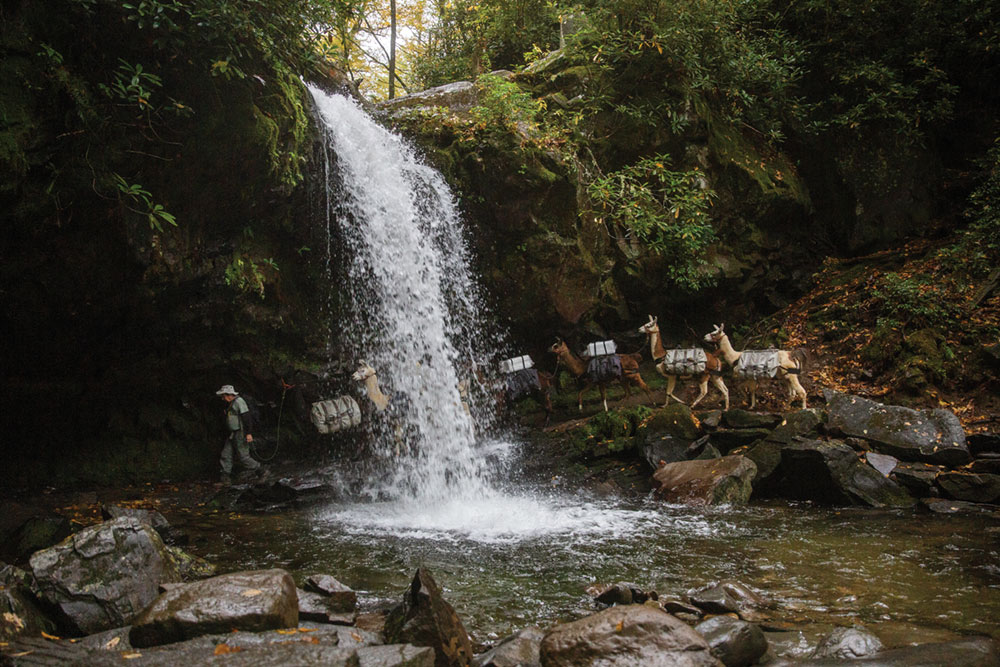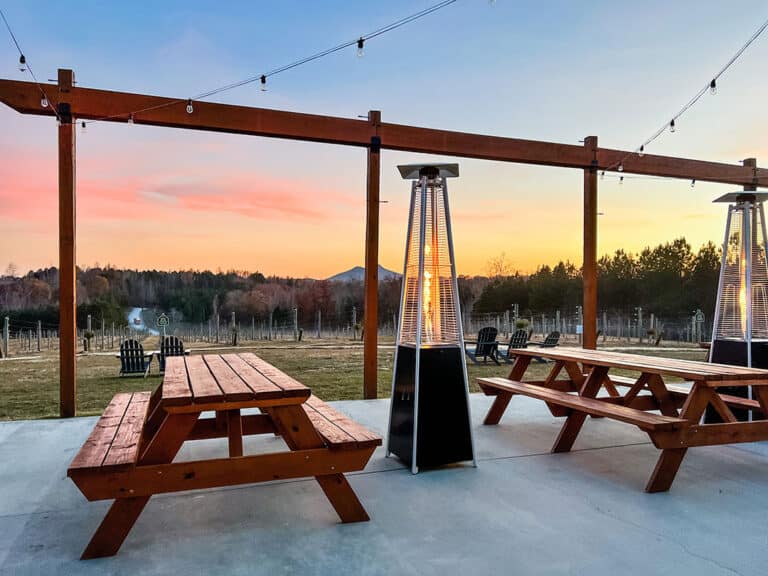The Llama Wrangler on Mount LeConte
It was 5:15 a.m. and pitch dark when Alan Householder parked the livestock trailer at the Trillium Gap trailhead at the foot of Mount LeConte. The autumn leaf change was in full swing in Great Smoky Mountains National Park, and by mid-morning, the parking lot would be overflowing.
But for now, Householder and his llama team were all alone. Working by headlamp, Householder brushed each llama and cinched their pack saddles. The cargo that day consisted of clean laundry and Styrofoam meal trays bound for LeConte Lodge, which is the highest overnight lodge east of the Mississippi River and only reachable by hiking one of five different trails.
When dawn broke at 7:15 a.m., Householder and his seven llamas were on their way.
“I will miss working with these guys,” he said. “They each have their own personality, and they don’t talk back.”
Except for a year-long hiatus in 2011 to have knee surgery, Householder, who’s 65, has been leading llamas for LeConte Lodge nonstop since 2002. Three days a week he and the llamas haul perishable foods, clean linens, and mail to the top of Mount LeConte via the Trillium Gap Trail—a nearly 14-mile round-trip hike with an elevation gain of almost 3,400 feet.
Householder’s llama packing trip that October day was one of his last. On November 24, the lodge’s last day of the 2020 season, Householder retired as LeConte’s llama wrangler, a job that surpassed his wildest dreams from day one.
“I took this job because I really like hiking,” he said. “I thought I’d last a couple of years and move on. There were days when it was raining, or I’d be really tired, and it felt like a job. But in the big picture, I always knew it was a great opportunity. I loved having the Trillium Gap Trail as my office.”
After 1.3 miles, the llama team reached Grotto Falls, one of the most photographed waterfalls in the Smokies. Every llama hauled between 40 and 60 pounds. Only in muddy sections of the trail did their soft footpads leave any tracks, and the whole procession was eerily quiet as it climbed up the north face of Mount LeConte.
In 1984 LeConte Lodge switched to llamas to reduce trail erosion. Before that, horses and mules had been used for 60 years. Through the lead rope, Householder could feel the rhythm and mood of the llama train. A coal-black llama named Jack was in the lead, followed by Cooper, Jimmy, Bruno, Rueben, Little Deer, and Andy.
“Jack is a leader because he doesn’t mind having a person in front of him,” explained Householder. “He’s as laid back as a llama can be.”
Just beyond Grotto Falls, Householder placed nylon mesh masks over the llama’s muzzles—not to discourage them from spitting, but to prevent them from chomping on waxy-green plants like rhododendron and mountain laurel that could make them sick. Stream crossings gave the team a chance to drink, and there were several stops along the trail where the llamas took designated potty breaks.
From black bears sneaking up behind the llamas to having the entire team slide down the mountain after one member slips and falls, Householder has experienced his share of “llama drama.”
“The hardest thing for the llamas is working in the summer,” Householder said. “They like it cold.”
Householder’s rapport with the llama team rose to a new level in 2014 when he married Chrissy Mann (now Chrissy Householder). They met as crew members at LeConte Lodge. In addition to working as a labor and delivery nurse, Chrissy tends to the llamas’ health needs and accompanies Householder up the mountain whenever she can.
“I learned a lot of llama psychology from Chrissy,” Householder said. “Llamas don’t want affection; they want respect. At first I’d bark orders at them, but that was the wrong approach.”
Householder and the llama team reached LeConte Lodge—elevation 6,400 feet—at noon. The lodge and kitchen were roped off due to COVID-19, but there were plenty of guests.
“Alan has gone above and beyond to see that the lodge gets what it needs, and the llamas get what they need,” says John Northrup, general manager of LeConte Lodge, about Householder. “People think it’s an easy job, just hiking all day with these fuzzy, cute animals. But it tests you in every way.”
A major ingredient in the llama wrangler’s job is the sheer amount of walking. During the lodge’s nine-month season, Householder hiked a total of 1,300 miles. Walking is in Householder’s DNA. He has completed the Appalachian Trail, as well as the Pacific Crest Trail. In 1997 he and guidebook author Allen DeHart became the first to hike the Mountains-to-Sea Trail from Clingmans Dome in the Smokies to the Outer Banks of North Carolina.
And in the winter of 2005-2006 Householder became the first American to complete the 435-mile Australian Alps Walking Trail from Melbourne to Sydney.
The trip down the mountain that afternoon posed more challenges than the climb up. The pack saddles were filled with dirty laundry and trash. At each rest stop, the llamas emitted a soft, low-frequency hum reminiscent of Buddhist monks chanting in deep meditation. Householder said this was not a sign of contentment, but of restlessness.
“They’re anxious to get back to the parking lot,” he said.
During the descent, Bruno, the third llama in line, kept stalling, which caused the line to bunch up. Patient as always, Householder dropped the lead rope and went up and down the line, feeding each llama a carrot and whispering in each left ear. After several minutes, the team was back underway, this time in perfect formation.
“I feel for these guys,” Householder said. “They’ve already made it to the top. For them, going back down is the final insult.”
On the job: Alan Householder leads llamas on Mount Leconte. Photo by Jessica Tezak








